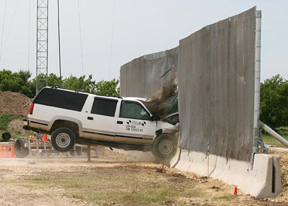
A joint effort involving a group of Sandians to test and evaluate various types of fencing along the US border with Mexico is helping decision makers determine appropriate fencing solutions.
The effort got under way in April with a series of crash tests to evaluate how the fences will look and perform. The tests stem from the government’s commitment to deploy hundreds of miles of fencing along high-traffic, high-risk stretches of the border.
Sandia was tapped by the Fence Lab, an initiative within SBInet, to help develop and execute its fence evaluation program. A part of the Department of Homeland Security’s Customs and Border Protection (CBP) directorate, SBInet is the technology network component of the Secure Border Initiative (SBI) and is responsible for integrating personnel, infrastructure, technologies, and a rapid response capability into a comprehensive border protection system.
As successful as the fence tests were, Sandia has the capability to include other aspects of intrusion delay and detection and other advanced security technologies, says Brian Damkroger (8130). Brian leads Sandia’s Borders and Maritime Security program, an element of its Homeland Security & Defense Strategic Management Unit, which functions as a virtual organization spanning — and drawing upon — both sites and several centers. Sandia’s border security efforts range from systems analysis and R&D on new detection technologies to field testing of deployed systems.
Brian was originally contacted by Fence Lab project managers in late 2006 to explore potential collaborations. Though CBP program managers were aware of Sandia, notes Brian, they hadn’t yet visited the lab and wanted to learn more about its capabilities. A December meeting convinced CBP that Sandia could clearly provide the technical depth needed for the project.
For the recent Fence Lab activities, the team assembled personnel from 6400, 6700, and 8100, with Mark McAllaster (6422), a member of Sandia’s Active Response and Denial Department, serving as principal investigator. Following the crash tests and initial evaluations, the Sandia team and its collaborators provided their assessments and recommendations on May 11.
“CBP was delighted with our work,” says Mark. He says CBP was particularly impressed with the team’s ability to pull together all the project elements — materials procurement, fence installations, vehicle purchases, and the crash tests themselves — in the required eight-week time frame. “It required an extraordinary effort by a lot of people,” says Mark.
In addition to the tight deadline, weather emerged as a factor in the test and evaluation activities. An unusually wet April and May led to several close calls, Mark says, and a staff member at the Texas Transportation Institute (TTI) is routinely assigned to observe weather radar information to keep test and evaluation staff up to date on changing conditions. Still, tests were occasionally in jeopardy of being postponed, and a severe downpour occurred only 10 minutes after the conclusion of testing on one particular day. “When you have to pull off nine tests in eight weeks, every day on the schedule counts,” Mark says.
Sandia has more than 50 years of experience developing and testing physical security systems for the nation’s nuclear stockpile and facilities, including the execution and documentation of many tests of both commercial and custom vehicle barrier designs. Its researchers conduct physical security activities for DOE facilities as well as special DoD sites.
Mark and other Sandia team members, including Rita Baca (10248), Ken Black (8134), and Tim Crawford (6755), applied that expertise to the testing of candidate fence technologies at TTI. The tests involved nine separate fences being developed and constructed under the direction of CBP.
The fences, six of which were designed by commercial companies around the country and constructed onsite in Texas (the other three were designed and recommended by CBP), were selected from a much larger group of proposals submitted in response to a solicitation from CBP and Boeing. Last year, Boeing was awarded a contract to perform as the lead system integrator for the overall SBInet effort.
The vehicle barrier component of the fences evaluated by Sandia at TTI came in three varieties: cable-style, surface-mounted, and bollard-style. Though the evaluators aren’t at liberty to reveal how each of the tested fences performed, border locales such as those in El Paso or San Diego have different terrains, population densities, or other environmental factors that necessitate pedestrian fences and vehicle barriers with different characteristics than a barrier that would be deployed in the wide open, rural areas of southern New Mexico.
“The border agents we interacted with were extremely helpful to us,” Mark says. “They gave us some really useful insight into how current barriers are being defeated by the adversaries, intelligence that we can then use when recommending future barrier designs.”
Now that the eight-week first phase of the fence test effort has been completed, Brian and Mark anticipate that the next phase of the Fence Lab project will begin quickly.
“Discussions have already begun around next steps,” Brian says. “A lot of things are happening at once, but we’ll probably be looking at some mix of design, deployment, and additional testing. Right now, we’re waiting for the green light from SBInet management.”
Brian and Mark emphasize that physical fences are only one component of a comprehensive border security system, and only one of several areas where Sandia is involved in border security work.
“Sandia doesn’t merely analyze fence barriers,” Mark says. “Our capabilities are truly state of the art and encompass the full spectrum of physical security, including intrusion detection alarm assessment technologies, performance testing, technology evaluation, vulnerability assessment, design, development, installation, and training.”